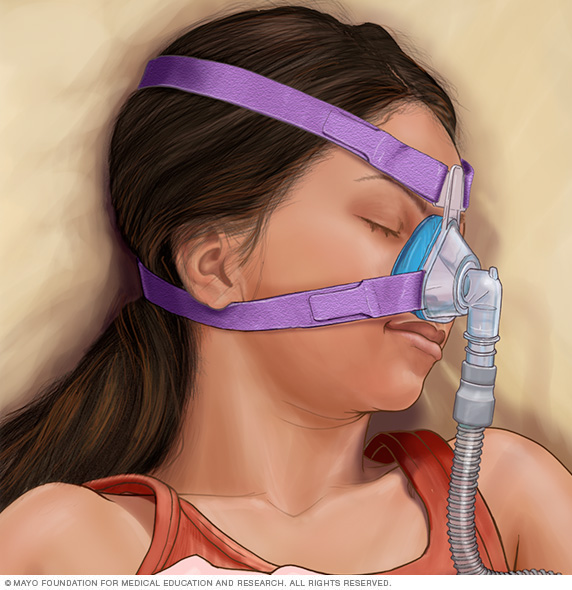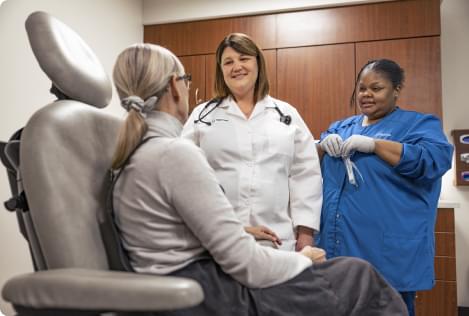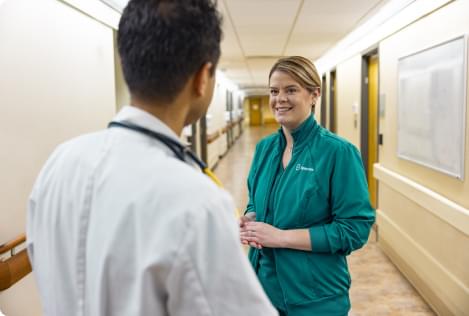Overview
Pediatric obstructive sleep apnea is a sleep disorder in which your child's breathing is partially or completely blocked during sleep. It can happen several times a night. The condition occurs when the upper airway narrows or is blocked during sleep.
There are differences between pediatric obstructive sleep apnea and adult sleep apnea. While adults usually have daytime sleepiness, children are more likely to have behavioral problems. The cause in adults is often obesity, while in children it's often larger than usual adenoids and tonsils. The adenoids are two small pads of tissue found in the back of the nose. The tonsils are two oval-shaped pads in the back of the mouth.
Early diagnosis and treatment are important to prevent complications that can affect children's growth, cognitive development and behavior.
Symptoms
During sleep, symptoms of pediatric sleep apnea might include:
- Snoring.
- Pauses in breathing.
- Restless sleep.
- Snorting, coughing or choking.
- Mouth breathing.
- Nighttime sweating.
- Bed-wetting.
- Sleep terrors.
Infants and young children with obstructive sleep apnea don't always snore. They might just have disturbed sleep.
During the day, children with sleep apnea might:
- Perform poorly in school.
- Have trouble paying attention.
- Have learning problems.
- Have behavioral problems.
- Have poor weight gain.
- Be hyperactive.
When to see a doctor
Make an appointment with your child's health care professional if your child wakes up in the morning feeling tired and has behavioral problems on a regular basis.
Causes
In adults, obesity is a common factor in obstructive sleep apnea. While obesity plays a role in the disorder in some children, obstructive sleep apnea is more commonly related to enlarged tonsils and adenoids. Other underlying factors may include being born with a birth defect related to the shape of the face or head. They also may include neuromuscular disorders that affect the way muscles function because of problems with the nerves and muscles in the body.
Risk factors
Besides obesity, other risk factors for pediatric sleep apnea include having:
- Down syndrome.
- Birth defects in the skull or face.
- Cerebral palsy.
- Sickle cell disease.
- Neuromuscular disease.
- History of low birth weight.
- Family history of obstructive sleep apnea.
Complications
Rarely, pediatric obstructive sleep apnea can cause a failure to grow in infants and young children. Children with obstructive sleep apnea who don't receive treatment also may be at an increased risk of later developing high blood pressure, high cholesterol, prediabetes, and other heart and blood vessel conditions. Very rarely, children who have certain genetic conditions can have serious symptoms of pediatric obstructive sleep apnea that can lead to death. However, complications can be managed with treatment.
Diagnosis
To diagnose pediatric sleep apnea, a health care professional reviews your child's symptoms and medical history and conducts a physical exam. Your child's health care professional will likely look at your child's head, neck, nose, mouth and tongue. Your child might need tests to diagnose the condition.
Tests might include:
- Polysomnogram. This test involves an overnight sleep study. Sensors applied to the body record brain waves, breathing patterns, snoring, oxygen levels, heart rate and muscle activity while your child sleeps.
- Oximetry. Oximetry is an overnight recording of oxygen levels that can be done at home. While this test can't establish a diagnosis of obstructive sleep apnea, the results may help your child's health care professional decide if further sleep apnea testing is needed.
Treatment
Your child's health care professional works with you to find the most appropriate treatment for your child's sleep apnea. Treatment might include:
- Medicines. Topical nasal steroids, such as fluticasone (Flovent HFA, Xhance, others) and budesonide (Rhinocort, Pulmicort Flexhaler, others), might ease sleep apnea symptoms for some children with mild obstructive sleep apnea. For kids with allergies, montelukast (Singulair) might help relieve symptoms when used alone or with nasal steroids.
- Removal of the tonsils and adenoids. For moderate to severe sleep apnea, your child's health care professional might refer your child to a pediatric ear, nose and throat specialist. The specialist may discuss removing your child's tonsils and adenoids. An adenotonsillectomy (ad-uh-no-ton-sil-EK-tuh-me) might improve obstructive sleep apnea by opening the airway. Other forms of upper airway surgery might be recommended, based on the child's condition.
-
Positive airway pressure therapy. In continuous positive airway pressure (CPAP) and bilevel positive airway pressure (BPAP), small machines gently blow air through a tube. The tube is attached to a mask affixed to your child's nose or nose and mouth. The machine sends air pressure into the back of your child's throat to keep your child's airway open. Pediatric obstructive sleep apnea often is treated with positive airway pressure therapy when medicines or removal of adenoids and tonsils aren't effective.
Proper fitting of the mask and refitting as the child grows can help the child tolerate the mask over the face.
- Oral appliances. Oral appliances, such as dental devices or mouthpieces, may be recommended. The devices help to expand the palate and nasal passages. They also might move your child's bottom jaw and tongue forward to keep your child's upper airway open. Only some children benefit from these devices.

Lifestyle and home remedies
- Avoid airway irritants and allergens. All children — especially those with pediatric obstructive sleep apnea — should be kept away from exposure to tobacco smoke or other indoor allergens or pollutants. They can cause airway irritation and congestion.
- Weight loss. If your child is obese, a health care professional may recommend weight loss. The health professional can give you and your child diet and nutrition information or refer your child to specialists in managing obesity.
Preparing for an appointment
You'll likely start by seeing your child's primary care professional. Or you might be referred immediately to an ear, nose and throat specialist or a sleep medicine specialist.
Here's some information to help you get ready for your appointment.
What you can do
Make a list of:
- Your child's symptoms, including any that seem unrelated to the reason for your appointment.
- All medicines, vitamins or other supplements your child takes, including the doses.
- Questions to ask your health care professional.
For pediatric obstructive sleep apnea, some basic questions to ask your health care professional include:
- What tests are needed?
- Is this condition likely temporary or chronic?
- What's the best course of action?
- What are the alternatives to the primary approach you're suggesting?
- Should I take my child to a specialist?
- Are there brochures or other printed material I can have? What websites do you recommend?
Don't hesitate to ask other questions.
What to expect from your doctor
Your child's health care professional is likely to ask you questions, such as:
- Does your child snore?
- What else have you observed about your child's sleep?
- Does your child have problems paying attention?
- Does your child have trouble with learning?
- Do you have a family history of obstructive sleep apnea?
© 1998-2024 Mayo Foundation for Medical Education and Research (MFMER). All rights reserved. Terms of Use


